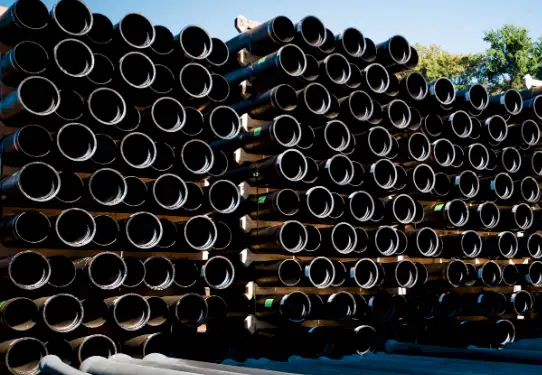The cost of ductile iron pipes varies based on several factors, including the pipe’s diameter, length, coating type, and other project-specific requirements.

What is Ductile Iron Pipe?
A ductile iron pipe is a type of cast iron pipe that is specially treated to enhance its flexibility and durability. Unlike traditional cast iron, which can be brittle and prone to cracking, ductile iron pipes can withstand higher stresses and are less likely to break under pressure. They are primarily used in water distribution systems, sewage, and other utility infrastructures.
Key Properties of Ductile Iron Pipes:
-
Strength: Ductile iron pipes have high tensile strength, making them ideal for heavy-duty applications.
-
Corrosion Resistance: The pipes are coated with a layer of cement mortar or bitumen to resist corrosion.
-
Longevity: These pipes have a service life that can exceed 100 years with proper maintenance.
Factors Influencing the Cost of Ductile Iron Pipe
The price of ductile iron pipes varies depending on several factors. Understanding these factors will help you estimate the total cost of your project.
1. Pipe Diameter
The larger the diameter of the pipe, the higher the cost. Larger pipes require more material and are more expensive to manufacture.
2. Length of the Pipe
The length of the ductile iron pipe required for a project significantly impacts the cost. Longer pipes often come with bulk discounts, but transportation costs can also increase for longer distances.
3. Coating and Lining
The type of coating or lining applied to the ductile iron pipe also plays a significant role in its cost. Common coatings include:
-
Cement Mortar Lining: Provides protection against corrosion.
-
Epoxy Lining: Used for high corrosion-resistant applications.
-
Polyurethane Coating: Offers additional protection from external environmental conditions.
4. Location and Shipping
Shipping costs vary depending on the geographical location of the supplier and the distance to the installation site.
5. Quantity Purchased
Buying in bulk often results in cost savings. The cost per unit typically decreases as the quantity increases.
6. Manufacturer and Brand
The reputation and quality standards of the manufacturer or brand can affect the price. Established brands with a proven track record of high-quality pipes may charge higher prices.
Average Cost of Ductile Iron Pipe
The cost of ductile iron pipes can vary widely based on the factors mentioned above. On average, the price of ductile iron pipes ranges from $5 to $15 per foot. However, this cost can fluctuate based on pipe diameter, length, and additional treatments. For large-scale projects, the cost can be much higher, especially when transportation and installation are considered.
| Pipe Size (Diameter) | Cost Per Foot | Coating Type | Estimated Project Cost (1,000 feet) |
|---|---|---|---|
| 4 inches | $5 – $7 | Cement Mortar | $5,000 – $7,000 |
| 6 inches | $6 – $8 | Epoxy Lining | $6,000 – $8,000 |
| 12 inches | $9 – $12 | Polyurethane | $9,000 – $12,000 |
| 24 inches | $12 – $15 | Cement Mortar | $12,000 – $15,000 |
Benefits of Using Ductile Iron Pipe
Ductile iron pipes offer numerous benefits, which is why they are commonly used in water and sewer systems:
-
Durability: These pipes are resistant to cracking, corrosion, and wear and tear.
-
Flexibility: Unlike traditional cast iron, ductile iron pipes can bend to a certain degree without breaking.
-
Long Service Life: With proper installation and maintenance, ductile iron pipes can last over 100 years.
-
Environmental Impact: Ductile iron is recyclable, making these pipes a sustainable choice for infrastructure projects.
6 Commonly Asked Questions (FAQs)
1. Why are ductile iron pipes more expensive than PVC pipes?
Ductile iron pipes are typically more expensive than PVC pipes due to the material cost, manufacturing process, and the added benefits of durability and strength. While PVC pipes are cheaper, they do not offer the same long-term reliability and resistance to external pressures that ductile iron pipes provide.
2. How long does a ductile iron pipe last?
Ductile iron pipes are known for their longevity, often lasting more than 100 years with proper maintenance. This is significantly longer than many other pipe materials, such as PVC, which generally have a lifespan of 50 to 70 years.
3. What is the best coating for ductile iron pipes?
The best coating depends on the application. For water systems, a cement mortar lining is often used for corrosion resistance. For aggressive environments, an epoxy or polyurethane coating might be preferred to provide extra protection against chemicals and external conditions.
4. Are ductile iron pipes environmentally friendly?
Yes, ductile iron pipes are environmentally friendly due to their durability and recyclability. The materials used to make ductile iron pipes can be recycled at the end of their service life, making them a sustainable option.
5. How much does installation of ductile iron pipes cost?
Installation costs can vary depending on location, labor rates, and the complexity of the project. On average, the installation of ductile iron pipes can cost between $50 to $150 per linear foot, including labor and materials. Additional costs may include excavation, permits, and other project-specific factors.
6. Can ductile iron pipes be repaired if damaged?
Yes, ductile iron pipes can be repaired. The repair process typically involves using a pipe clamp or sleeve to seal the damaged section. For more extensive damage, a replacement section of pipe may be installed.
Conclusion
Understanding the costs and factors influencing the price of ductile iron pipes is essential for anyone involved in infrastructure projects. These pipes are a durable and reliable option, particularly for water and sewage systems, and while they may come at a higher initial cost compared to alternatives like PVC, their longevity and strength make them a wise investment for the long term.
